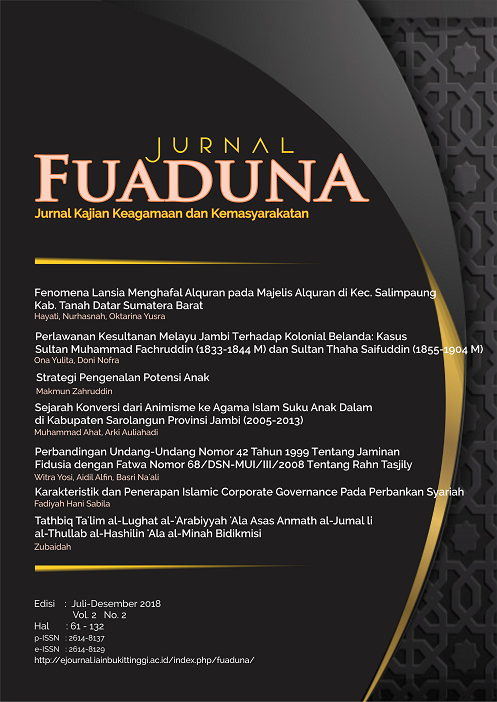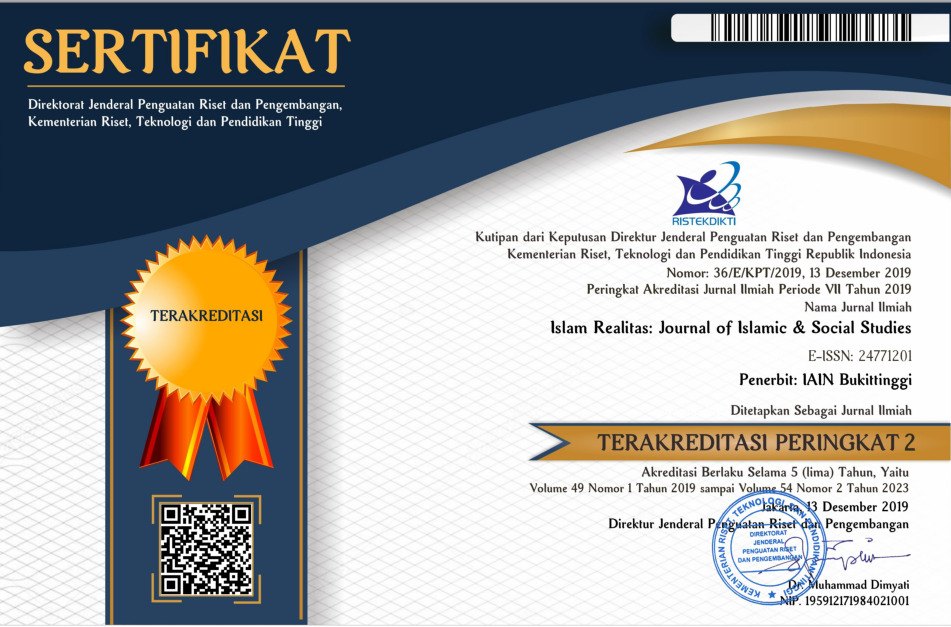SEJARAH KONVERSI DARI ANIMISME KE AGAMA ISLAM SUKU ANAK DALAM DI KABUPATEN SAROLANGUN PROVINSI JAMBI (2005-2013)
DOI:
https://doi.org/10.30983/fuaduna.v2i2.2070Abstract
References
Melalatoa, J.. Ensiklopedi Sukubangsa di Indonesia. Jilid A—K (Jakarta: Departemen Pendidikan dan Kebudayaan, 1995), h. 34.
Dokumen, Kantor Taman Nasional Bukit Duabelas Kabupaten Sarolangun tahun 2013
http//www. Pemberdayaan Komunitas Adat Terpencil, Jambi.com, (23 Agustus 2000), diakses 4 Mei 2013, jam 22.30.Wib.
Hafied Cangara, Pengantar Ilmu Komunikasi, (Jakarta: PT Raja Grafindo Persada, 2003), h. 156.
http// Surat Kabar, Kompas Jambi,Jumat 4 Mei 2012
Al-Haris, Bupati Merangin, melalui sidang paripurna ulang tahun Kabupaten Merangin ke-49, di pola Kantor DPRD Kabupaten Merangi, Pidato, tanggal 8 Agustus 2014.
Budhi Vrihaspathi Jauhari, Arislan Said, Jejak Peradaban Suku Anak Dalam, (Bandung: Widya Padjajaran , 2012), h 23
Dokumen, Kantor Kementrian Agama Kabupaten Merangin Tahun 2013.
Dokumen, Kantor Kementrian Agama Kabupaten Sarolangun Tahun 2013.melalui KasiPembinaan dan pengembanan Si‟ar Islam. Drs.H. Suhaili.Mengatakan upaya yang sedang dilakukan oleh Kemenag Kabupaten Sarolangun dalam pemberdayaan terhadap Suku Anak Dalam yang telah masuk agama Islam adalah pengenalan tentang ajaran Islam secara menyeluruh melalui Penyuluh Agama Honorer.
Aswab Mahasin, dkk, (ed.), Ruh Islam dalam Budaya Bangsa: Aneka Budaya Nusantara, (Jakarta: Yayasan Festival Istiqlal, 1996), h. 39.
Zakiah Daradjat, Ilmu Jiwa Agama, Jakarta: Bulan Bintang, 2005, h.160
Richard W. Bulliet, Conversion to Islam and Emergence of Muslim Society in Iranâ€dalam Levtzon, Nehemia, h. 30
Uka Tjandra Sasmita (ed,). Sejarah Nasional Indonesia III, (Jakarta, Grafitas, 1975), h.122
Downloads
Published
Issue
Section
Citation Check
License
Authors who publish with this journal agree to the following terms:
- Authors retain copyright and grant the journal right of first publication with the work simultaneously licensed under a Creative Commons Attribution-ShareAlike 4.0. that allows others to share the work with an acknowledgment of the work's authorship and initial publication in this journal.
- Authors are able to enter into separate, additional contractual arrangements for the non-exclusive distribution of the journal's published version of the work (e.g., post it to an institutional repository or publish it in a book), with an acknowledgment of its initial publication in this journal.
- Authors are permitted and encouraged to post their work online (e.g., in institutional repositories or on their website) prior to and during the submission process, as it can lead to productive exchanges, as well as earlier and greater citation of published work (See The Effect of Open Access).







